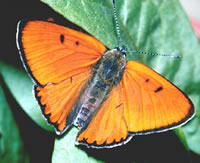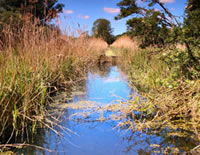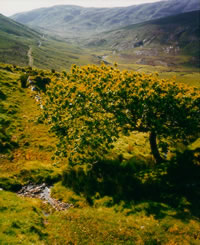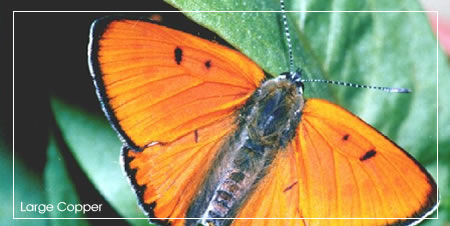 EXTINCT BUTTERFLIES of Ireland
EXTINCT BUTTERFLIES of Ireland
The Irish Large Copper Butterfly
The Large Copper L.dispar dispar became extinct in England around 1864 due to the great reduction and drainage of it's marshy fen habitat. This was a result of the expanding human population at that time. In 1909 an attempt was made to introduce a subspecies L.dispar rutilus which was commonly found in Europe but this was only a partial success and required constant management of the fen to ensure that the larval foodplant of Giant Water Dock was available in sufficient quantities and growing in the right places.
About 1912 Mr.W.B. Purefoy lent lands including a snipe bog in Greenfields, Co.Tipperary so that an attempt could be made to introduce the Large Copper to Ireland. Preliminary work commenced by way of clearing the land and planting the roots of Giant Water Dock which were  imported from England. Capt.E.B.Purefoy oversaw the project and in May 1913 ten dozen larvae of L.dispar rutilus were imported from Herr H. Ragnow of Berlin but these produced only eight butterflies. In May 1914 Capt. Purefoy travelled to Germany and collected nearly 700 larvae in the marshes north of Berlin but when he returned to Ireland it was found that most of these larvae were parasitised and as a result only about 300 butterflies actually emerged. However a spell of good weather helped and these butterflies quickly set about laying eggs on the Giant Water Dock and for the first time a breeding colony had been established in Ireland.
imported from England. Capt.E.B.Purefoy oversaw the project and in May 1913 ten dozen larvae of L.dispar rutilus were imported from Herr H. Ragnow of Berlin but these produced only eight butterflies. In May 1914 Capt. Purefoy travelled to Germany and collected nearly 700 larvae in the marshes north of Berlin but when he returned to Ireland it was found that most of these larvae were parasitised and as a result only about 300 butterflies actually emerged. However a spell of good weather helped and these butterflies quickly set about laying eggs on the Giant Water Dock and for the first time a breeding colony had been established in Ireland.
With careful management the colony survived until 1928 but that was it's last year in existence and sadly it died out. A further re-introduction attempt was made and these butterflies survived until about 1938. A last attempt was made in 1943 and this colony survived until about 1953.
They were the last of the Irish Large Coppers and no further re-introduction attempts have been made.
The Small Mountain Ringlet
A famous butterfly collector called Mr Edwin Birchall claimed to have collected a series of these butterflies halfway up Croagh Patrick in June 1854 and one of these specimens resides in the National Museum in Dublin. There is another specimen believed to have been captured by Rev.R. McClean on the east shores of Lough Gill in 1895. Yet another collector W.F.Kane claimed to have seen specimens in the Nephin Mountains in County Mayo in 1900 although he does not seem to have captured any of them.
There are a total of 6 specimens in existence of which 3 may be genuine and 3 which are of unknown origin but could be Irish as they are labelled Kane 1903.
This is a small and elusive butterfliy and difficult to find at the best of  times in Scotland and Europe. It will only fly in bright sunshine and colonises east facing areas of grassland containing Mat Grass but the butterfly is not generally found below 2000 ft. altitude.
times in Scotland and Europe. It will only fly in bright sunshine and colonises east facing areas of grassland containing Mat Grass but the butterfly is not generally found below 2000 ft. altitude.
So why the doubt?
After 1903 Croagh Patrick was searched many times and not a single Mountain Ringlet was ever found. The Eastern shore location for the Lough Gill specimen turned out to be a most unsuitable habitat for this species and well below it's normal altitude. Also the actual specimen label states Sligo but the eastern end of Lough Gill is in Leitrim. The Nephin Mountains are a real possibility of a suitable habitat with the inaccessable Nephin Beg being a good bet. However around 1940 the whole side of this mountain caught fire after a drought and this may have destroyed the species, if it ever existed there.
Maybe someone reading this may be encouraged to investigate and make the discoveryentomologists have searched for since the start of the last century - it could be you.

